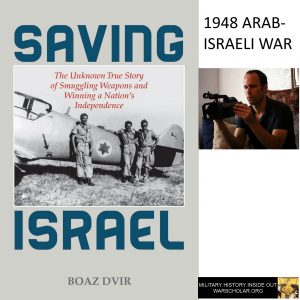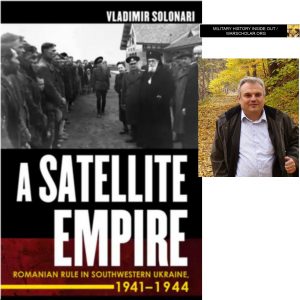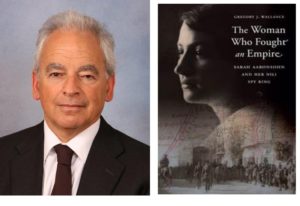Podcast: Play in new window | Download
Subscribe: RSS
 Check out this book here https://amzn.to/2ZnM73r
Check out this book here https://amzn.to/2ZnM73r
Boaz Dvir is a journalist, writer, and filmmaker. He spent ten years researching the creation of the Israeli Air Force in 1948. He produced a documentary on the subject titled “A Wing and a Prayer” which was shown on PBS. He then wrote a book on the subject. We spoke about the Israeli Air Force of 1948, the secret methods needed to create it, the writing of the book, and what it took to research it.
(THE AUDIO PLAYER IS AT THE BOTTOM OF THE POST.)
0:51 – Boaz talks about why he wrote this book.
3:41 – Boaz talks about how the Israelis were armed with Nazi weapons in 1948.
4:25 – Boaz summarizes what led up to the Arab-Israeli War of 1948.
7:35 – Boaz talks about what he focuses on in the book.
12:32 – Boaz talks about how the Arab were threatening to annihilate the Israelis.
14:41 – Boaz talks about the US Army flight engineer who started the operation to arm Israel.
19:59 – Boaz talks about how the Jewish-American underground set up an airline to fly people into Israel.
23:05 – Boaz talks about how Adolf became an international arms smuggler.
26:54 – Boaz talks about military resistance to the smuggling of weapons.
31:41 – Boaz talks about what the Israeli Air Force consisted of before the 1948 war and what had been created by the end of the war.
32:58 – Boaz talks in detail about the planes they brought into Israel.
35:35 – Boaz talks about the initial operations on both sides during the 1948 war.
39:22 – Boaz talks about the air war during the 1948 war and the initial Arab advantage.
41:54 – Boaz talks about how Israel used Nazi weapons in the 1948 war.
45:14 – Boaz talks about the research he did for the book.
49:10 – Boaz talks about coming across one of the old C-47s used in the 1948 war.
51:19 – Boaz talks about how amazing it was to talk to the US WWII veterans.
54:26 – Boaz talks about the emotional responses to this subject matter.
54:53 – Boaz talked about his surprise at US antagonism towards Israel in 1948.
59:10 – Boaz talks about how the USSR indirectly armed Israel.
1:04:01 – Boaz talks about influence of Jewish Russians on Israel.
1:05:22 – Boaz talks about the British pilots who flew against Israel and the shoot-down of a British reconnaissance plane.
1:08:21 – Boaz talks about the two types of Egyptian pilots that the Israeli pilots faced in 1948.
1:09:52 – Boaz talks about the victims of the war.
1:17:14 – Boaz talks about how the people in his book were innovative.
1:22:30 – Boaz can be found on facebook at Boaz Dvir and on twitter @BoazDvir.
Links of interest
https://twitter.com/boazdvir?ref_src=twsrc%5Egoogle%7Ctwcamp%5Eserp%7Ctwgr%5Eauthor
For more “Military History Inside Out” please follow me at www.warscholar.org, on Facebook at warscholar, on twitter at Warscholar, on youtube at warscholar1945 and on Instagram @crisalvarezswarscholar. Or subscribe to the podcast on Apple Podcasts | Google Podcasts | Stitcher | Spotify
Guests: Boaz Dvir
Host: Cris Alvarez
Tags: military, history, military history, conflict, war, interview, non-fiction book, tags: Israel, Holocaust, Arab-Israeli war, Nazi, Palestine, Jewish, United Nations, US Army Air Force, aviation, neutrality act, WWII, world war two, Britain, Trans-Jordan, ATC, concentration camp, RAF, Royal Navy, arms smuggling, arms embargo, Egypt, Iraq, Hawaii, US Navy, FBI, Czechoslovakia, California, New Jersey, 1948 war, dogfighting, pilots, Negev, B-17, El Al, Tel Aviv, Messerschmitts, Nazi, Spitfires, Syria, flight logs, Israeli Air Force museum, greatest generation, Soviet Union, Stalin, Ben Gurion, Cairo, P-51, Panama, Wing and a Prayer, PBS
Check out this book here https://amzn.to/2ZnM73r
As an Amazon Associate I earn from qualifying purchases.



